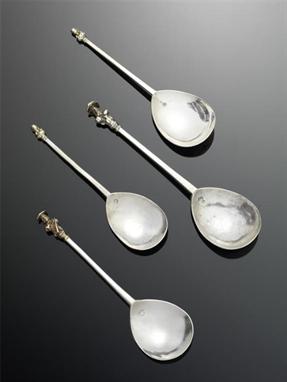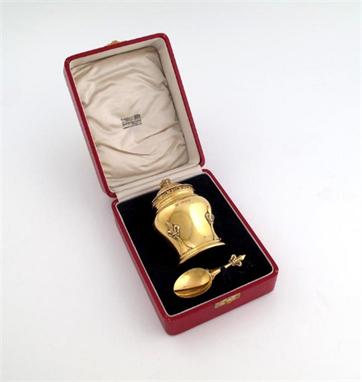We found 116099 price guide item(s) matching your search
There are 116099 lots that match your search criteria. Subscribe now to get instant access to the full price guide service.
Click here to subscribe- List
- Grid
-
116099 item(s)/page
A mixed lot of silver flatware, comprising: A H. Wilkinson and Co, Sheffield 1864, in the Gothic revival manner, with pierced crown finial, Sheffield 1865, in a fitted case, plus three silver lobster picks in two fitted cases, and a set of four electroplated Rat-tail pattern sauce ladles, engraved with the Cipher of Queen Elizabeth II, approx. weighable 5oz. (8)
A mixed lot of silver flatware, various dates and makers, comprising: a pair of fruit serving spoons, twisted stems, the terminals with a Lincoln Imp finial, Sheffield 1900, a pair of late Victorian trefid spoons, London 1898, a pickle fork, a tea strainer, a set of six pierced teaspoons, a butter knife and three teaspoons and a knife, , approx. weight 15oz. (qty)
An Elizabeth I West Country silver Maiden Head spoon, marked twice R.O, for Richard Osbourne, Exeter late quarter of the sixteenth century, the finial with traces of gilding, length 16.8cm, approx. weight 1oz. Provenance: purchased from Woolley and Wallis, Early Spoons, 30th October 2002, lot 104. for maker`s mark see Tim Kent, West Country Silver Spoons and Their Makers, 1550-1750, J.H Bourdon-Smith Limited, 1992, page 116.
An early 19th century continental silver sugar vase and cover, probably Italian, vase form, decorated with swags above acanthus leaf decoration, leaf capped scroll handles, pull off cover with foliate decoration and a ball finial, with six cut out spoon holders, on a raised square base on four paw feet, height 21.5cm, approx. weight 14oz.
A 19th century Australian silver mounted emu egg box, by William Edwards, Melbourne, circa 1865, the stem modelled as two palm trees supporting the emu egg, hinged cover, (repairs to egg), gilded interior, trailing vine scroll handles and mounted with a finial modelled as two emus, on a shaped oval rocky foot , mounted with an aboriginal figure and a kangaroo, height 26cm.
A Victorian silver modelled as an ostrich, part marked for London, maker`s mark of Martin Goldstein, modelled in a standing position, on a wooden base, height on base 20cm. As the ostrich is only part marked it would indicate that the item was originally a finial for a cup and cover or the handle for a meat dish cover.
A silver-gilt tea caddy and caddy spoon, by The Goldsmiths and Silversmiths Company, London 1936, baluster form, applied with fleur de lys decoration, and a chased border of lions, pull-off cover with a crown finial, the caddy spoon with a fleur de lys, inscribed, in a fitted case, height 10.8cm, approx. weight 6oz. (2)
A Victorian parcel gilt claret jug, by Reily and Storer, London 1841, baluster form, silver body with pierced silver-gilt overlay cage-work with trailing vines and bunches of grapes, simulated vine scroll handle, the hinged cover with a bunch of grapes finial, the whole on a spread foot, height 32.5cm.
An Elizabeth I silver-gilt mounted tigerware jug, by Richard Brooke, London 1580, baluster form, scroll handle, the mounts with stylised foliate decoration, double acorn thumb-piece, domed hinged cover with a seated lion finial, on a raised circular foot, height 26cm. For maker`s mark see Jacksons, Ian Pickford Edition, The Antique Collector`s Club, 2002, page 100. Illustrated in Michael Clayton, The Collector`s Dictionary of Silver and Gold of Great Britain and North America, The Antiques Collectors Club, 1985, page 255.
A George III silver ewer, by William Holmes, London 1787, classical vase form, wicker-bound scroll handle, the body with rosettes and swags above part fluted decoration, beaded borders, engraved with an armorial, domed hinged cover with an urn finial, the whole on a raised circular and square foot, height 29.3cm, approx. weight 26oz.
A George III silver two-handled cup and cover, by Charles Wright, London 1775, circular baluster form, beaded leaf capped scroll handles, the domed pull-off cover with a cone finial, central girdle above chased lobed and vine decoration, on a raised circular foot, engraved with an armorial and crest, height 29.5cm, approx. weight 40oz. The arms are those of Williams of Malvern Hall, Solihull with another in pretence impaling Umfraville.
A small George III silver tea urn, by William Holmes, London 1784, urn form, with reeded loop handles, bright-cut decoration and beaded borders, raised pull off cover with a cone finial, engraved with a shield and crest, with an ivory tap, on a raised square base on four ball feet, the interior with an unmarked hot metal rod holder, height 35cm, approx. weight 38oz. The arms are those of Peard of Barnstaple, Devon.
A George II silver tankard, by John Swift, London 1732, tapering circular form, central girdle, scroll handle with a later initial, the domed hinged cover with a pierced thumb-piece and knop finial, the front engraved with an armorial, on a raised circular foot, height 21cm, approx. weight 28oz The arms are those of Kirke of Eastham, Essex. The shield incorporates the augmentation granted in 1759 to David Kirke, Governor of Newfoundland, to Lewis Kirke, Governor of Cananda, and to Thomas Kirke, Vice-Admiral of the British fleet, for thier victory over the French and consequent capture of Canada.
A French gilt brass and champleve enamel clock garniture, with an 8 day movement by Vincenti & Cie, no. 12797 42, striking on a gong to an opaque and floral painted dial, within a four glass columned case with a domed surmount and floral finial, with six further bud finials, with twin tube mercury pendulum, 13.5in (34.5cm) h, and a pair of cut glass and mounted vases, 9.5in (24cm) h. (3) Winding key.
Scottish inlaid mahogany longcase clock, second quarter of the 19th century, the arched painted dial signed Peter Keir, Falkirk, subsidiary second dial and date dial, the refurbished painted lunette, with a named scene - "The Lady of the Lake", the spandrels emblematic of the union, eight-day movement, striking on a bell, the case with a broken swan-neck pediment and brass phoenix and sphere finial, short narrow door, parquetry banding over, bracket feet.
A silver copy of the Iona Nunnery spoon by Alexander Ritchie, Glasgow 1928, with the Iona mark in a rectangle and incuse ‘A.R.’ mark, the navette bowl with floral engraving, animal mask upper heel, an engraved stem with leaf wrapped stem above, with a cone shaped finial, 20cm (8in) long, 48g gross, in a fitted case. The original medieval spoon was excavated in the Nunnery grounds in 1923. Ritchie was able to have access to the original and made a few copies from his own moulds. It is also interesting to note that George Hunt made a version of this spoon hallmarked for 1936. See ‘George Edward Hunt The Silent World of an Arts and Crafts Jeweller’, A Touring Exhibition, November-December 2006, catalogue, exhibit 90.
-
116099 item(s)/page




























































